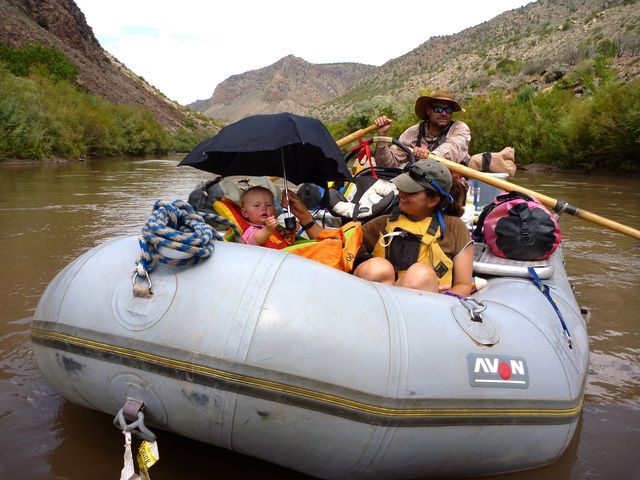
You know how sometimes you ask other parents, including your own, for advice or insight about kid-related quandaries, and so often people scratch their heads and mumble, “Uh, I can’t remember?” And you find this totally incomprehensible because parenting is so profound and mind-boggling that it will be burned on your brain forever and you will never, ever forget? Well, guess what, you will.
I’d forgotten, for example, how stressful it is to take a baby on a river trip. Of course it is! You are mixing a tiny, mostly helpless infant, moving water, and wilderness. But in the two short years since my littlest was a newborn, this fact had somehow slipped my mind. Until it came flooding back to me last weekend on a two-night float trip on the Rio Grande with our friends Elizabeth and Win and their 10-month-old daughter, Camille.
I’d forgotten that in the week leading up to baby’s first rafting trip you will be paralyzed with anxiety and nightmare visions of a baby tumbling overboard into muddy river water. You will be engaged in a private, protracted calculation about how many diapers to bring for how many days, and what the child should sleep in to stay warm. Do you put a blanket in the crib (because you know there is no way you are not bringing a portable crib), to keep her from freezing, even if she is less than a year old and it is August?
You can become consumed with these questions, including the most obvious of all: Are you insane and/or grossly negligent to bring a baby on a river? Even if your husband is a professional river guide who has led trips through the Grand Canyon for decades? Even if the section of river has one real rapid, which you have already agreed you will walk the baby around?

I had forgotten all this, so when Elizabeth called me the night before our trip and I missed her call, I mistakenly thought all she wanted was to confirm our meeting time the next day. Of course, what she really needed to talk about was diapers and rash cream and baby food and the sheer lunacy of it all. But I had forgotten about the pre-trip freak-out, a requisite part of any expedition with babies. I let my husband arrange the details with her and finished packing our family gear. I’d only just started an hour earlier. I’d been at a friend’s when I looked at the time and remembered that we were leaving for the river the next day. I gathered the girls and went home and began tossing rain jackets, pants, fleece, sun hats, river shoes, and rash guards into our dry bags, threw in some baby Advil, a couple extra pacifiers, some pull-ups, and two stuffed loveys, and called it good. I was done before dinnertime, and didn’t have one ominous thought the whole time. I took this as a sign that we finally had our shit dialed, which, as I would learn soon enough, was not entirely the case.
We had run this 20-mile section of the Rio Grande through White Rock Canyon three years earlier, when our older daughter was one, and my husband has done it several times since with his friends. As weekend float trips go, it couldn’t be more convenient. The put-in at Diablo Canyon is less than 45 minutes from Santa Fe, and you don’t need a permit. There’s one Class III rapid and plenty of decent campsites—at least on the upper half. You’re less than 20 miles from Santa Fe as the crow flies, and if you turn on your phone, you’ll get patchy service. But chances are you won’t see any other boaters the whole time. It feels remote and wild, but it’s as close as you can get to your own backyard. All of which makes it a perfect choice for baby’s first river trip.
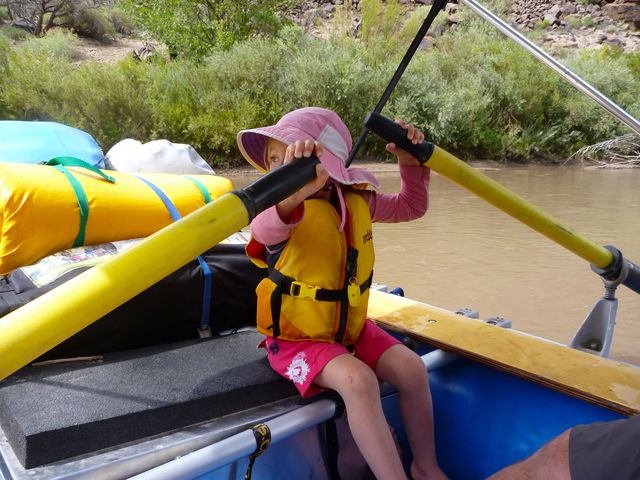
But every river trip is different, just like every river is different every time. When we got to the put-in, the sky was trying to spit rain and the Rio looked low. It was low: It had come down from 1,000 cubic feet per second to 500 since the last time we’d checked a couple days earlier. Still, it didn’t seem particularly worrisome, especially when the river surged a bit, thick with mud and debris from a storm washing out a canyon upstream. “It’ll float our boats,” I think I remember Steve saying.
We estimated that we had only a handful of miles to go that first day, and would be at camp in about an hour. This is another thing I’d forgotten: When you’re trying to find a “sweet campsite” that your husband scouted on his last trip and remembers it being “about an hour” from the put-in, multiply that by two. At least. We finally pulled in shortly before 6 p.m., just as the girls were starting to fuss. We’d already broken the cardinal rule of river tripping with kids: Shorten your days and get to camp early. It was well after dark before we got the tents up and the kids fed and to bed and finally had time to sit down for our own dinner, chicken fajitas next to the fire. But it was a sweet site, on a grassy bank above the river, with shady cottonwoods and a clear-running spring with a small waterfall and swimming hole where we lounged and dunked the next day before breaking camp.
If the anticipation is the most stressful part of baby's first trip, the first 24 hours run a close second. There are so many unknowns: Will the baby cry the whole time? Will she hate her lifejacket? Will she nap on the boat? But once you survive that first night, and you realize that most likely no one is going to die—and that’s the only thing that really matters—you can relax into the flow of being in the backcountry, on a beautiful river, without contact with the rest of the world. This is river mind, that rare blissful feeling of just going with the flow, no distractions.
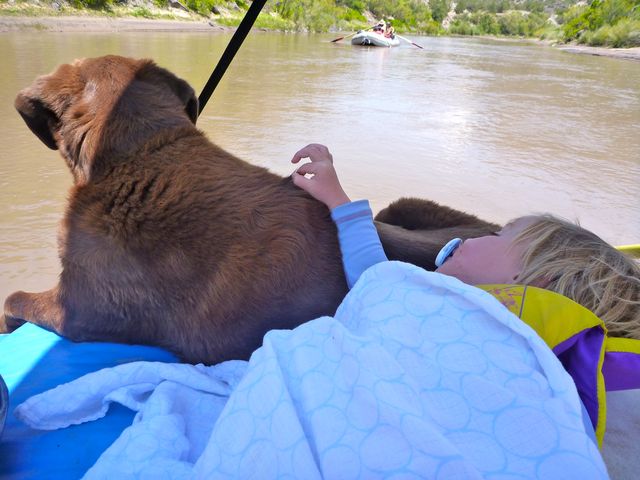
Baby Camille got into river mind right away, crashing out in the tent on cue, enduring her PFD without complaint, and even napping on the boat. I’d forgotten how easy it is when the baby is small and not yet walking and still mostly compliant and definitely not talking or whining or screaming no to you when you tell them it’s time to stop wrestling in the mud and rinse off in the river, like my girls did at our second camp, at the mouth of a wide canyon on a damp beach awash with logs and debris from the last storm.
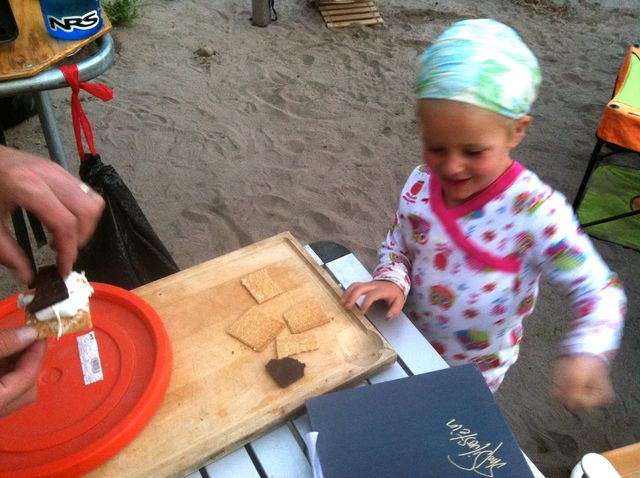
I’d also forgotten that in the backcountry you have to let go of certain things, like wanting your children to go to bed at a reasonable hour, even if they are bleary-eyed and it is still daylight and there are marshmallows to be roasted, and insisting that they eat a healthy meal or nap on the boat or use their manners, and caring about how filthy they are or how much sand they are eating every time they accidentally drop their food on the ground, which they do every five minutes. The sooner you can surrender to the dirty exhaustion and let them go feral, the faster you’ll get into river mind and the happier you’ll be.
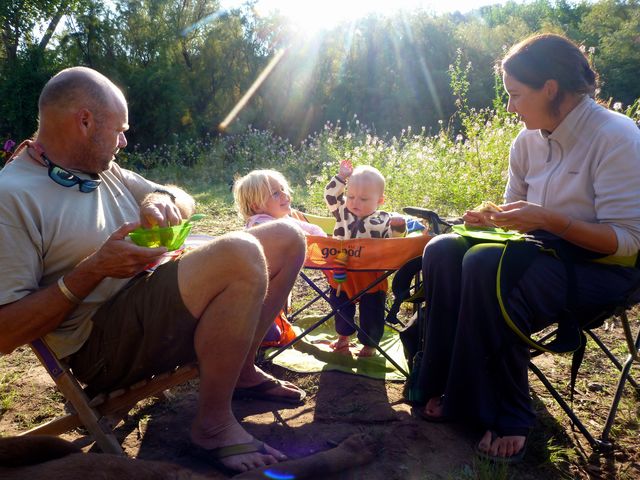
Elizabeth told me they wouldn’t have been motivated for this trip if it weren’t for us, and that’s exactly how we felt three years ago when we took our maiden voyage with a baby, on the San Juan, with our friends from Durango and their two kids. You need backcountry mentors, other families who have forged ahead of you and made mistakes and figured things out and lived to tell about it and reassure you that you are not insane. But what I’d forgotten is that mentoring goes both ways.
I learned from Elizabeth that it’s smart to pack a tube of aloe vera so you can wipe down sun-chapped faces and rashy bottoms before bed. And that a nice big picnic blanket doubles as a dish-drying station and a kiddy lounge and diaper-changing zone. I’d forgotten that whatever quantity of snacks you think you might need, double. And throw in some really verboten goodies, too—like Swedish fish—in case of mutiny. Also, it’s a good idea to write out your list of meals and the ingredients you need and tack it to the fridge before you leave, so, in your haste to pack, you don’t forget crucial provisions like oatmeal for the group’s oatmeal breakfast and curry powder for Saturday night Thai curry stir-fry. You learn something new on every river trip.
On the last day, we learned what to do when things get epic.
The trip had so far been a breeze. Camille had been born to be on a river, and my girls were mostly keeping it together. We’d had warm, clear weather. At night the sky was so bright with stars it looked like someone had thrown a saltshaker into the sky. We’d swum and mud-bathed and roasted s’mores and floated a lot of little rapids and walked around the one big one. No one had fallen out of the rafts—except on purpose. It seemed too short. Already I wanted more river time. Well, we’d get it. We had 10 miles to the take-out on Cochiti Lake, and the biggest water was behind us. What was in front of us, though, was the shallowest.
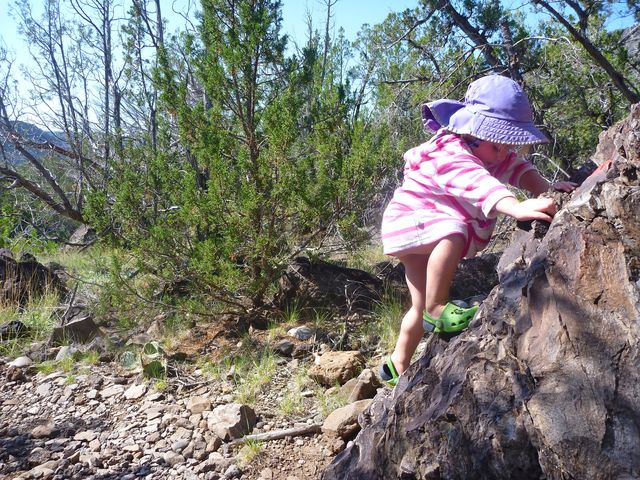
Cochiti Lake is formed by a dam, and on its approach to the lake the Rio Grande becomes slow and lazy and lake-like. At 1,000cfs, the river is passable but slightly tedious. At 500cfs, it is a minefield of sand bars. We had a long day, made longer by the fact that we had to get out every few minutes to drag our raft to deeper water. It was blazing hot, and our girls were crushed. I’d forgotten that, with older kids, sometimes the last 24 hours are the hardest, when they’re overtired, sun-dazed, and snacked out.
After lunch, two-year-old Maisy finally surrendered to fatigue and fell asleep sitting up in my arms. The raft grew unusually quiet. Even our three-legged dog was passed out beside me on the Paco pad. Then I heard an odd muffled honking noise. I looked back and four-year-old Pippa had crashed, face down, on the dry bags. She was snoring. The raft drifted lazily along the shore, past swallow nests clinging to rock walls and great blue herons resting on sandbars. Rafting with kids is rarely relaxing, but you do occasionally get moments of rare silence and real contentment. Like this one. Then the wind began to blow.
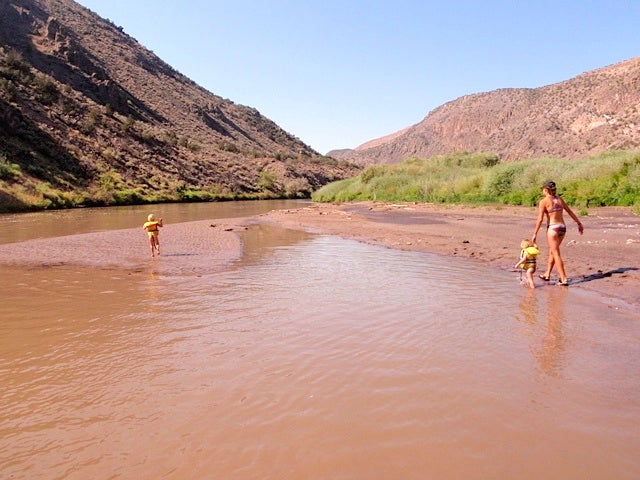
At first it was a brief blast that seemed destined to pass, but within a couple of minutes it had begun to howl. The sky was bunched up with grey clouds, and we were sandwiched between two storms, one to the north and one to the south. The river was wider here, and the wind was kicking up whitecaps and pushing us back upstream. It looked like a miniature ocean. We lost sight of Win and Elizabeth’s boat as they rounded a bend, fighting the gale just as the wind slammed us into a craggy wall on river left, pinning us there no matter how hard Steve dug in with the oars. It seemed impossible to row through this, so Steve grasped for a tamarisk branch and tied up to wait it out.
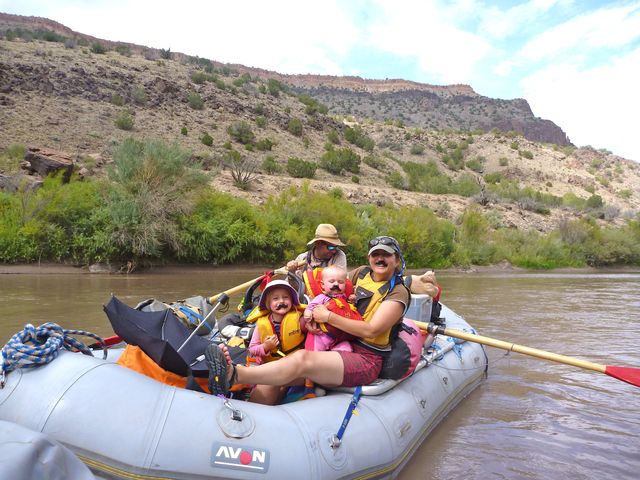
Many minutes passed, with the girls—both rudely awakened—screeching into the gale. A couple of kayakers passed us, heading downstream but upwind, and told us it was “three miles to the takeout.” I forgot that when someone says that to you in such circumstances, you should halve that number, at least. I pictured the lake choppy with waves, a small-craft warning flags raised, and worried about how we’d make it across if the lightning started. I began to run through a mental list of our rations: a few ounces of milk, a few spoonfuls of yogurt, leftover rice, a handful of Swedish fish, a couple of energy bars, and marshmallows. The shoreline was thick with brush, but if we had to, we could find a sheltered place to carve out a camp for the night. Elizabeth and Win were gone, but that was only right, I reasoned: After all, they had a 10-month-old. They needed to save themselves.
After a while, I noticed the whitecaps were not so frothy or menacing. The wind was still bending the willows backwards, but if we were going to make a run for it, now was the time. The whole sky could open up at any minute. Steve pushed off and rowed hard into the wind, bracing with his back. Any progress was better than none, so I placated the girls with bars while they chanted “Go daddy, go” and he rowed us all the way to the mouth of the lake. The water was muddy and choked with thick, brown flotsam, blown up from the other end of the lake. There, a dot near the far shore, was Win’s boat, waiting for us like a toy raft bobbing on a cesspool. It wasn’t pretty, but it seemed like we would make it after all.
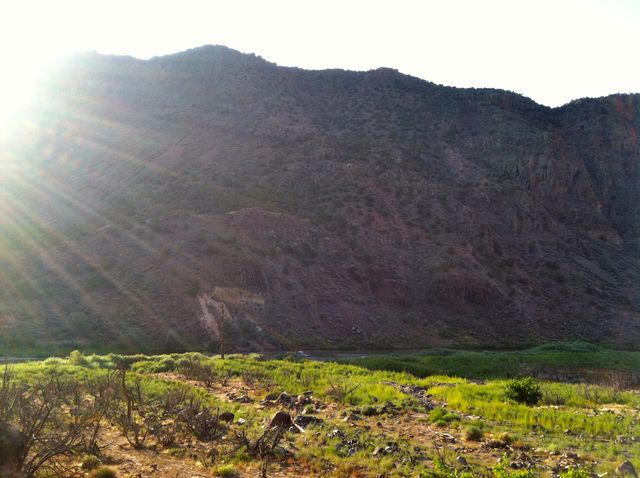
And we did. Our flotilla reunited, we rowed to the takeout before the rain came. Baby’s first epic was over, and from the safety of a concrete boat ramp busy with day fishermen, it seemed like it had never been all that dire in the first place. But I’d learned a lesson: Epics can happen, even with babies on board. And you have to be prepared. Next time I’ll remember to pack extra food, just in case we have to spend another night out. And we’ll do a better job of keeping our rafts closer together—and not simply because Win and Elizabeth had enough leftover fajitas to feed several families for several days. And probably we’ll think twice about floating White Rock Canyon on the Rio Grande when it’s flowing below 600cfs.
But mostly I’ll remember that the thrill of the unknown is what makes an adventure, and that to spend a couple of days with friends and children drifting down a wilderness river is always worth it in the end.
—Katie Arnold